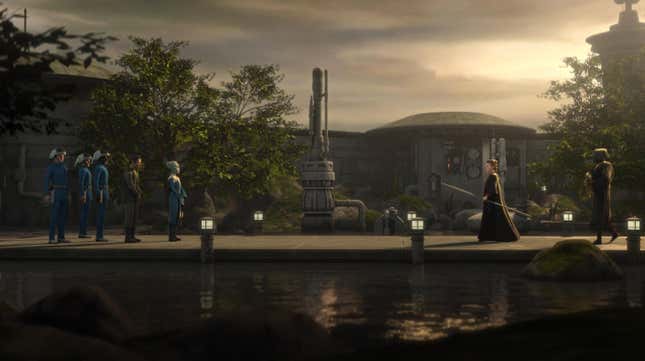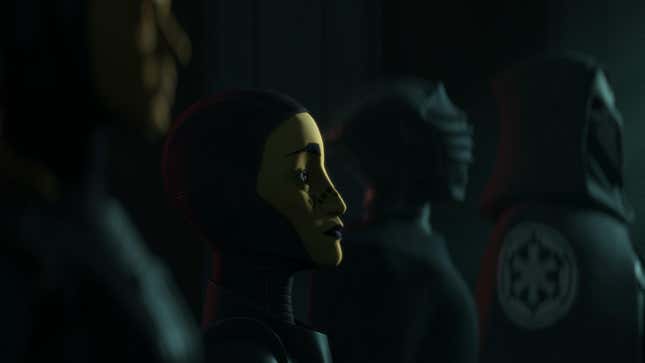Two years ago, Star Wars stepped into a new animated format with Tales of the Jedi, examining the stories of two characters ostracized by the titular order in Dooku and Ahsoka Tano. Now, in celebration of Star Wars Day this weekend, it’s trying again—this time with a touch of the Dark Side. But while Tales of the Empire finds stronger success than its predecessor, it manages to do so rather unevenly.
Tales of the Empire’s big questions are a mirror to Tales of the Jedi’s—more on the personal scope of its central characters, rather than questions of the institutions that tie them together. If Jedi asked its characters what it means to feel like the Jedi Order had left them behind, Empire asks Morgan Elsbeth and Barriss Offee (the returning Diana Lee Inosanto and Meredith Salenger, respectively) how they could possibly survive an evil like the Empire.
It does this, largely, by not really telling tales of the Empire itself across its six episodes, but tales of the need to survive that drives these two women in very different directions. Although the idea of the “Good” Imperial was much more commonly explored in the old Star Wars expanded universe—from the political machinations of TIE Fighter to the novels’ exploration of the Imperial Remnant as an eventual sibling galactic power to the New Republic—contemporary Star Wars’ examination of Imperial figures leans more introspectively rather than at the logistics of the Empire as an entity, into looking at how individual beings across the galaxy are pushed into, or caught up by, the masquerades of its villainy. It’s here that Tales finds purchase for Morgan and Barriss alike—one caught in a cycle of revenge, the other driven by survival in a world that’s turned her upside down—by giving them both individual goals and wants out of interacting with the Empire and its structures.

This individual response and approach to the Empire as a catalyst means, of course, that the stories told through its lens can veer wildly in terms of satisfaction, even if they are all loosely connected by their relationship to the Imperial structure. That’s definitely the case for Tales of the Empire, which is unfortunately clearly split in the middle between one story repeatedly hitting a single note as it draws to a vague conclusion for its protagonist, and the other, albeit similarly vague, offering much more to chew on by directly challenging the anthology’s premise.
Sadly, it’s Morgan Elsbeth’s story that really suffers here. Feeling constrained by what we knew of the character when she was introduced in The Mandalorian and then further touched on in Ahsoka, Morgan’s arc in Tales feels less like an actual journey for her character and more like shuffling her to specific points on a chessboard—her time as a Nightsister, her time working with Thrawn, her time as a magistrate on Corvus. While Inosanto delivers a strong performance with the material she gets here, there’s just not enough time given across three 10-15 minute snippets to really dig into what drives Morgan. All we get is her desire for revenge in the wake of the Nightsisters massacre during The Clone Wars, leaving her characterization as angry and wounded feeling particularly one-note, especially as Tales never finds anything to really say about Morgan carrying that anger across decades of her life. Nothing learned here emotionally sets up the figure we meet in Mandalorian and then eventually Ahsoka, and instead comes across like checking boxes off of a wiki entry.

But where Morgan’s side of Tales of the Empire stumbles, it soars in its exploration of Barriss Offee in a post-Order-66 world, faced with the horrifying decision of death at the new regime’s hand, or survival as part of its long shadow in the Imperial Inquisitorius.
If Morgan’s story in Tales is restricted by what we already knew of the character’s future, and of her end, Barriss’ is unleashed by the unprecedented potentiality it sees in her as a character. Barriss Offee is a rare character in Star Wars’ arsenal: a figure who played a climactic role in a major inflection point in continuity, the Padawan turned architect of a bombing at the Jedi Temple that directly lead to Ahsoka Tano’s exit from the Order in Clone Wars, but one that has been left completely untouched in over a decade by its continued storytelling. We don’t know where Barriss’ journey into the Inquisition’s grip is going to take her, giving her side of Tales a remarkable tension that is otherwise lacking in Morgan’s story. But Tales also just uses Barriss and the limited time with her more effectively too. While similarly vague as Morgan’s, in that the three episodes jump across broad moments of time instead of diving particularly deeply into a particular moment in Barriss’ life after Clone Wars, the nature of the story Tales wants to tell about Barriss adapting to survive the Empire’s existence allows her character to grow and change over a much more satisfying arc.

That aforementioned broadness however, is a more general issue with Tales of the Empire, rather than something consigned to one half of the narrative or the other. Both stories here are trying to tackle ideas that are put into episodes too short and sharp to really afford the time worth spent digging into them. A lot is left on the table, for better or worse: either because there wasn’t that much there to say in the first place for some characters, or because Tales needs to leave things open for future stories to pick up on what it puts down. Tales of the Empire is clearly interested in wanting to try and tell something deep and personal about these two characters and their relationship to the Empire, and what drives them beyond it, but while one side works much better than the other, it doesn’t quite manage to really do it all justice in the time the format affords itself.
This was a problem Tales of the Jedi suffered from too—Ahsoka and Dooku’s fates, like Morgan Elsbeth’s, were already known, and the bits of their stories Tales explored were strongest when they pulled away from those fated destinies to ask questions about the institution that bound them. Uninterested in exploring the Empire beyond acting as a catalyst for these two disconnected characters, Tales of the Empire struggles to find meat to chew at large. While its greatest strength comes from playing with the unexpected in Barriss Offee’s narrative, that’s still only 30 minutes with a character Tales clearly had interest in exploring for much longer than that. The potential for more is there—but perhaps Tales of the Empire’s biggest success is in proving that there will be better avenues to tell these tales in the future.
Star Wars: Tales of the Empire begins streaming on Disney+ this Saturday, May 4.
Want more io9 news? Check out when to expect the latest Marvel, Star Wars, and Star Trek releases, what’s next for the DC Universe on film and TV, and everything you need to know about the future of Doctor Who.




















+ There are no comments
Add yours